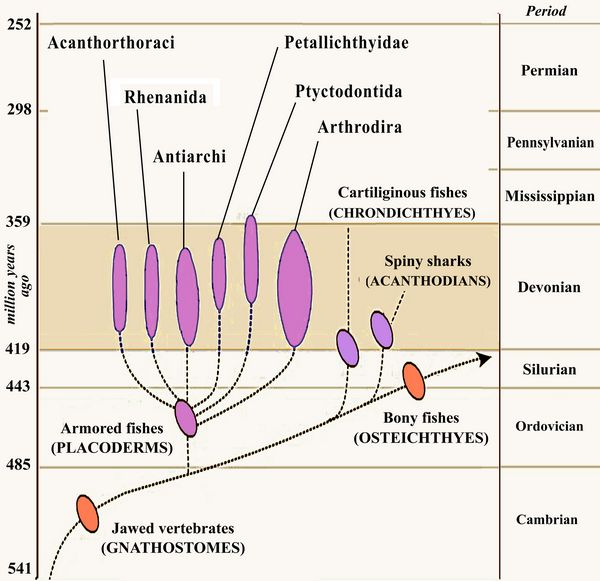Athena Review Image Archive ™
Placoderm groups in timeline

Placoderm groups in timeline (after Benton 2005; chart: Athena Review).
Placoderms ("plate-skin," from Greek plak, "plate" or "tablet", and -derma, "skin") were a class of armored fish that were among the first jawed vertebrates (gnathostomes). They lived in the Early Silurian through Late Devonian periods (443-359 mya). More than 250 genera of placoderms are known, with one genus, Bothriolepis, having nearly 100 species, making Placoderms the most diverse and important of Devonian vertebrates.
The earliest studies of placoderms were published by Louis Agassiz (1833-1843). Placoderms were then thought to have been shelled jawless fish related to ostracoderms. In the late 1920s, Dr. Erik Stensio of the Swedish Museum of Natural History established more accurate details of placoderm anatomy, and identified them as true jawed fishes, and related to sharks. This view of the relationship between sharks and placoderms has been complicated, however, by the discovery of the Silurian jawed placoderm Entelognathus (Zhu et al 2013).
The
first appearance of Silurian placoderm fossils in China show the fishes
had already differentiated into the Antiarch and Arthrodire orders,
along with other, more primitive groups. Numerous families of
placoderms flourished during the Devonian, but became extinct at the
end of that period, perhaps due to competition from the bony fish
(osteichthyans) and early cartilagenous sharks (chrondichthyes). They
also died out during massive extinction events at the end of the
Devonian, and the start of the Mississippian period.
The
jaws of placoderms likely evolved from the first gill arch of ancestral
jawless fishes. Their head and thorax were covered either with fused
armored plates, or a mosaic of unfused scales, while the rear part of
the body was variably covered or uncovered, depending on the taxa.
Their backbone consisted of a cartilaginous notochord (an embryonic
feature in higher vertebrates) that persisted throughout life. Their
vertebra consisted only of Y-shaped spines, sometimes
cartilaginous, located above and below the notochord. Their
paired fins and a heterocercal tail suggest that they could swim
efficiently (Janvier 1996).
Their body armor was very
likely a defense against the giant sea-scorpions that inhabited
brackish water environments. It also may have functioned as a kind of
exoskeleton, and (as with arthropods and mollusks) as a support for the
external organs, supplementing their weak, mainly cartilaginous
internal skeleton.
References:
Agassiz, L. 1833-1843. Researches on Fossil Fish, 5 vol.
Benton, M.J. 2005. Vertebrate Paleontology. Blackwell Publishers.
Janvier, P. 1996. Early Vertebrates. Clarendon Press, Oxford
Stensio, E. 1925. The Downtonian and Devonian Vertebrates of Spitzbergen. Stockholm.
Zhu, Min et al. 2013. A Silurian placoderm with osteichthyan-like marginal jaw bones. Nature 502, pp.188–193
Copyright © 1996-2020 Rust Family Foundation (All Rights Reserved).